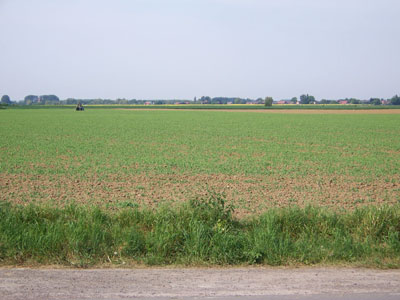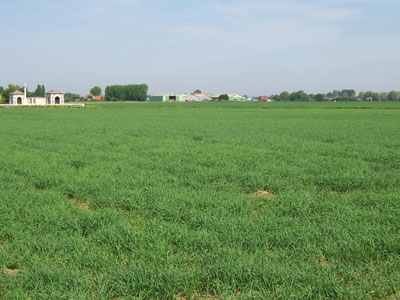
WWII: Maginot Line | Normandy | V-Weapon Sites | Arnhem
Further afield: Crete
| Home Tracing Military Ancestors Travel Advice CWGC Cemeteries Iron Harvest News Book Reviews Glossary Links Contact Me Artois:
 
|
Location 1 – Australian Memorial Park, Fromelles and VC Corner CWGC Cemetery
Directions – If you're staying in Arras and visiting this area as part of a more extensive trip to Vimy Ridge and the central sector of the Artois battlefields, the best route (and one that avoids any motorway tolls) is to take the N17 north to Lens transferring to the A21 around its northern suburbs. Take the N47 north at Junction 10 in the direction of La Bassée and just to the north of the town at the roundabout, take the first exit to Lille on the N41. At the third roundabout on the N41, take the last exit sign-posted to Fournes-en-Wappe and, on entering the village, take the first left, the D141, to Fromelles. Take the right in the centre of the village to Sailly-la-Lys. The Australian Memorial Park will be passed on the right. If coming from Calais take the main A26 Autoroute towards St Omer and pick up the N1042 that skirts the town to the south following signs to Hazebrouck on the N42. Stay on this road to the north of Hazebrouck and exit south onto the D947 following signs to Estaires. Drive through the village and take the D122 to Sailly-la-Lys and continue along the D122 and D175 towards Fromelles. The Australian Memorial Park will be passed on the left. Getting Your Bearings – This area was a focal point in the Battles of Aubers Ridge on 9th May 1915 and Fromelles on 19th July 1916. Before exploring the Australian Memorial Park and nearby VC Corner CWGC Cemetery, it's worth familiarising oneself with the key surrounding topographical features. With your back to the Memorial Park:
View 1 – across the road to your left is the ground assaulted by the British 61st Division on 19th July 1916. The British trenches ran away to the south-west in front of the current treeline, roughly where the yellow rape field is on the photograph. The heavily fortified German position known as the "Sugar Loaf" was approximately to the left of the lone tree in the middle distance with the German front line (Necklace Trench) continuing across the field straight towards the camera position.
View 2 – To the right of the Cross of Sacrifice in VC Corner CWGC Cemetery amongst the trees up ahead is the sector assaulted by the 14th Brigade of 5th Australian Division on 19th July. This front was also attacked during the earlier Battle of Aubers Ridge in May 1915, this time by the British 8th Division, with battalions deployed from left to right, the 2nd East Lancashires, 2nd Rifle Brigade and 1st Royal Irish Rifles. The Australian Memorial Park – Opened on 5th July 1998, the Australian Memorial Park is situated on the German front line of 19th July 1916. Together with a memorial at Hamel on the Somme, it is the result of a long campaign by Australian historian, John Laffin, supported by the Australian military, to commemorate and honour the sacrifice of so many Australians during the First World War. The statue itself, in bronze and sculptured by Melbourne-based Peter Corlett, depicts Sergeant Simon Fraser of the 57th Battalion carrying a wounded comrade back to the Australian lines. Incidentally, the blockhouses in the park, whilst interesting, were not built by the Germans until 1917 and the damage was caused by local farmers in trying to remove them!
VC Corner CWGC Cemetery – When this section of the battlefield was cleared after the Armistice, the remains of 410 unknown Australian soldiers were interred in two mass burial plots, later marked by white crosses. The Australian Memorial at the back of the cemetery displays the names of all 1,299 Australian soldiers killed at Fromelles with no known grave. It is the only all-Australian cemetery on the Western Front and the only CWGC Cemetery with no headstones. It takes its name from the award of four Victoria Crosses to soldiers involved in the earlier Battle of Aubers Ridge.
Historical Notes – At 5:43pm on the evening of 19th July 1916 the German trench here, held by the 3rd Battalion, 21st Bavarian Reserve Infantry Regiment, was at the centre of the Australian 5th Division attack, led in this sector by the 53rd and 54th Battalions of the 14th Brigade. The 53rd Battalion, advancing on the western side of the road, had the furthest distance to cover – 250 yards of no-man's land. Despite casualties suffered from a German bombardment and machine gun fire from their right flank "A" Company made it across and, with "B" Company, cleared the German front line trench. On their left the 54th Battalion, with just over 100 yards to cross, also took the German front line trench, reaching the breastwork before the defenders could man it. It was at this point, however, that the attack began to go badly wrong. With orders to reach the German second and support lines, the Australians advanced onward but, without most of their officers who had already become casualties, the attack soon stalled in the face of German artillery, machine gun and rifle fire from uncaptured positions on the flanks and ahead. Meanwhile, with the attackers searching for the elusive second line trenches, German troops began to counter-attack along their front line trench to the Australian's rear. Despite bringing up two support companies, the Australians were gradually pinned down and then decimated. When the call to retire came at 5:00am the area was littered with the dead and dying of both sides. For the British infantry of the 8th Division, the earlier assault on 9th May 1915 was no less deadly. The bombardment was ineffective due to lack of shells and heavy calibre guns, leaving much of the German barbed wire untouched. The 2nd East Lancashires only got half way across no-man's land before they were halted by withering fire. With some gaps in the barbed wire in their sector, the 2nd Rifle Brigade and 1st Royal Irish Rifles did slightly better, capturing the German front line and taking some prisoners. German fire, however, from the flanks and further up the ridge, made it impossible to bring up reinforcements and by the evening, the British command gave the order to withdraw. For less than 24 hours fighting it was nothing short of a massacre – 1,579 men were killed, missing or wounded from these three battalions alone. Eyewitness Account – An NCO of the 53rd Battalion described the scene that greeted him as he advanced to support the first wave on 19th July: "The moment they cleared the parapet it became hideous with machine-gun fire. There was a slight slope – our line ran down it, and then went splash into the ditch up to their waists in water. It was slimy but it gave some protection…About forty yards along it the leader got hit in the neck by a machine-gun bullet. He choked – one of the gunners tied him up, and, with another, they lay there for half-an-hour or longer. The ditch was full of wounded and dying men – like a butcher's shop – men crying and groaning and shrieking." Extract from Fromelles by Peter Pedersen, 2004 Pen & Sword Books. Postcript – Following the opening of German archives of the period, Australian historians discovered that the Germans had in fact buried many of the British and Australian missing from the Battle of Fromelles in a mass grave behind their front line. Subsequent investigations have led archaeologists to uncover the remains of these men. Latest reports are that they will finally be laid to rest in a new cemetery nearly one hundred years after they were so tragically lost. |
|||||||||



